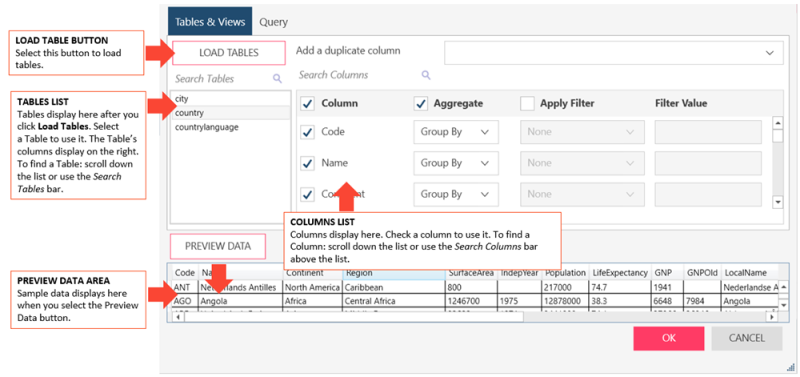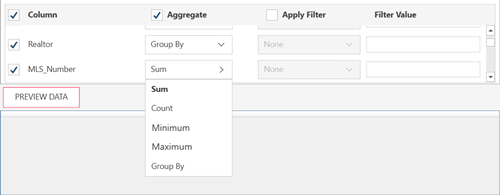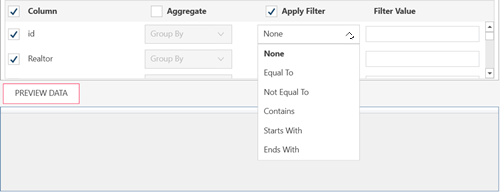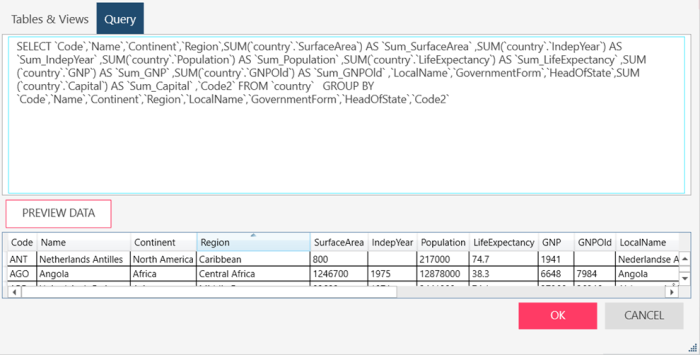Connector Dialog for Snowflake
Enter values into the dialog box to connect and fetch data from your Snowflake data source.
Note that the Snowflake ODBC driver requires one of the following Java Virtual Machines (JVM) to make it work:
-
Oracle JDK 8 or higher (LTS version)
-
OpenJDK 8 or higher (LTS version)
If the Snowflake connector is not available on the connectors list, follow these steps to add/enable Snowflake connector:
-
Download correct JRE files from, for example, http://jdk.java.net/ to any folder in the machine. You can also place it in C:\Program Files\Common Files\Altair\Drivers
-
Add the jvm.dll path to PATH System Environment Variables (for example: C:\Program Files\Common Files\Altair\Drivers\jre\bin\server). How to add environment variables is explained in https://java.com/en/download/help/path.xml.
-
Restart machine.
-
Launch Monarch Data Prep Studio. The Snowflake connector should now appear.
Options
|
Field |
Description |
|
Account Name |
The name of the machine or domain containing the data source. This host must be accessible from the box where Monarch Data Prep Studio is installed. |
|
User ID |
A valid User ID required to log-on to the data source. |
|
Password |
A valid Password required to log-on to the data source. This password must match the User ID above. |
|
Warehouse |
The name of the Snowflake warehouse. |
|
Schema |
The username provided for authentication with the Snowflake database. |
|
Other Connection Options |
Connection options required to connect to the data source. If you need multiple string connection options, separate these by a semi-colon. However, you can only enter up to a maximum of 512 characters into this text box. Available options and valid values are discussed here. |
|
Database |
Enter or select the database you want to connect to. For some data sources, you need to click Fetch Databases first to populate the database drop-down list. |
|
Tables and Views Section |
Allows you to load, and then select, the tables from your database by manually selecting from a list. To load tables and views via search and select:
Note: If you wish to add a duplicate column, select this column from the Add a duplicate column drop-down list provided. To Select a Column Check the boxes beside the columns you want to use. If you want to use all columns check the Column box on the header. To Aggregate Columns
If the data returned is to be aggregated, check the Aggregate box on the header, then select the aggregation method you want to use for each column. The following aggregation methods are possible for each data type:
To Filter Columns
If the data returned is to be filtered, check the Apply Filter on the header. Then, for each column, select a filter method from the filter drop down and then enter the filter value in the Filter Value box. Note that some data sources require case-sensitive filter values. Refer to this list to check which data sources have case-sensitive filters. To load tables and views using an SQL Query, select the Query tab |
|
Query |
Allows you to load, and then select, the tables from your database by entering a SQL Statement. If you already selected Tables and Views, this box is updated to show the corresponding SELECT * FROM TABLE query.
If you want to define the query, enter the SELECT, EXEC, and/or WITH statements to execute. Notes
|
|
Preview Data |
Click to fetch data using the credentials and criteria you have specified. This allows you to confirm your connection, ensure you have connected to the correct table, check your query, and verify the information that will be loaded. Notes:
|
Troubleshooting Snowflake Connection Problems
If the JRE bitness installed in the machine in which Monarch is also installed is incorrect, the Snowflake data source may fail to load. To fix this issue:
-
Ensure that Java JRE is installed with the correct bitness or architecture (e.g. use 32-bit JRE for 32 bit installs).
-
Check that the Path environment variable points to the correct jvm.dll location. In most cases, JRE installers will just add an entry to the path environment variable pointing to the root/main folder of the JRE files. You will need to manually edit the path in the environment variable to point to the exact folder where the jvm.dll is located.
-
Remove other Java JRE or JDK locations that may exist in the path environment variable.







